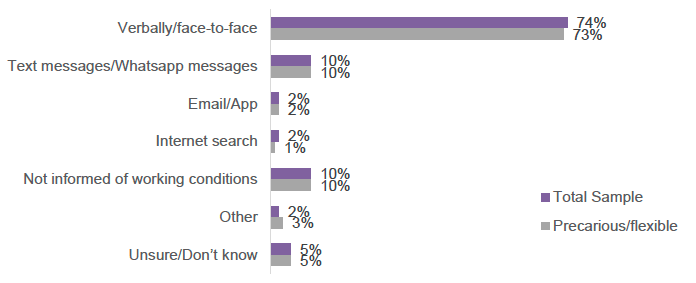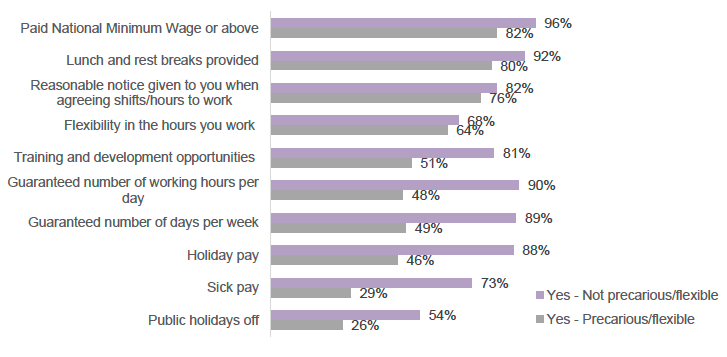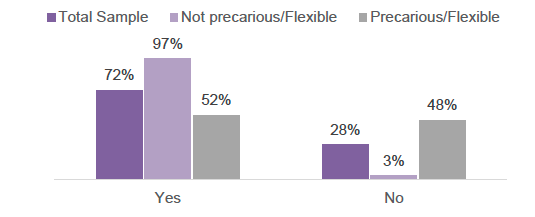Young people's experiences of precarious and flexible work – Main Report
The research report presents findings on young people's experiences of precarious and flexible work. These work conditions included where young people had for example zero hours contracts, low wages, lack of progression opportunities, dissatisfaction with current employment, or varying hours.
4. Awareness of contractual status
This chapter addresses RQ2: To what extent are young people aware of their contractual status and what factors, if any, determine levels of awareness, as shown in Table 1.2 in Chapter 1. This chapter reports the proportion that have a written, agreed contract as well as other employment rights. It also establishes the proportion that have a guaranteed minimum number of hours per week. Differences between sub-groups have also been reported.
Chapter 4 – Key points
Two thirds (66%) of the total sample have a written, agreed contract with their employer. However, a substantial minority (27%) of the sample did not, and this rises to nearly half (49%) for those in precarious or flexible work.
Most (74%) of those without a written contract were informed of their employment conditions verbally.
Young people in precarious or flexible work were less likely than others to be paid at least the minimum wage; be assured of a minimum number of hours work each week; receive holiday pay and sick pay, or have paid public holidays. Those not in precarious or flexible work were significantly more likely to have almost all of the employment rights that were evaluated compared to those in precarious or flexible work.
4.1 Contractual status
Figure 4.1 shows that two thirds (66%) of the total sample had a written contract with their employer. Just over a quarter (27%) didn't have a written agreed contract.
As explained above (see section 2.5 and Box 2.1), this is a key question used to determine if respondents were working in precarious or flexible positions or not: employees who said they didn't have a contract have been classified as being in precarious or flexible work, whereas those with a written agreed contract are mainly those not in precarious or flexible work.
Q5. Do you/did you have a contract that is/was written and agreed with your employer?

Base (all): 1,043
Amongst those categorised as in precarious or flexible work, the older group (20-24 year olds) were more likely to state they had a written agreed contract (50%) than the younger group (16-19 year olds: 36%).
The qualitative findings provided further insight into what young people view as a contract and how much they know about them. Overall, around a third of the qualitative respondents had a written, agreed contract. For some this was simply a written agreement that they were on a zero hours contract, for others it was a more formalised contract that detailed working hours, pay, etc. In some cases the contract had been sent to them as an email attachment, (some had not opened / read the attachment). Others either had a verbal agreement or no contract at all.
The majority of the qualitative respondents did not recall seeing or signing a written contract. When asked, some stated they consider themselves to be on a 'zero hours' contract. For some this was something that was presumed rather than confirmed by a manager.
"Well, are you not just on a zero-hour contract, if you're not on one [a contract]?" (Galashiels focus group participant)
For others who did not have a contract, did not consider themselves to be on a zero hours contract. They aren't guaranteed a minimum number of hours, they just turn up for work when asked and are paid the national minimum wage based on their age.
"No I don't [have a contract], it's incredibly casual sort of thing it's really just a phone-call, turn up sort of idea. I really have no power over what hours or any control." (Edinburgh focus group participant)
"No I don't have a contract, it is very badly structured. I get a text, it can be like 4 days before they want you to come in or like half an hour before they want you to come in." (Galashiels focus group participant)
"I haven't really seen or signed anything, if I'm honest" (Glasgow focus group participant)
A couple of qualitative respondents referred to a 'verbal agreement'. They know what their hourly rate is and how many hours a week they have worked and it was just agreed verbally. This supports the quantitative results reported at Figure 4.2.
"Verbally they've told me they will give me twenty hours a week if I will accept that and I can do more on top of that." (Edinburgh focus group participant)
The qualitative research findings also suggested that those working in smaller, more family-run businesses, were less likely to have a written contract, agreed hours or structured breaks etc., typically to allow the company to offer flexible services and respond to the changing demand for services.
The TUC's Living in the Edge report (2016), as reported in the evidence review, found that a lack of a contract or written agreement, or even a payslip, were noted as potential contributing factors in making workers feel vulnerable and workers expressed a sense of worthlessness because of levels of insecurity experienced.
For the quantitative respondents who did not have a contract, the majority tend to find out about their working conditions such as contracted hours, benefits, etc. verbally from their employer (Figure 4.2).
For those in precarious or flexible work 10% found out via text messages or Whatsapp. There was also 10% of the respondents in precarious or flexible work who stated they were not informed of their working conditions.
Q8. How do you find out about the conditions of your employment such as contracted hours, entitlement to benefits?

Base (all without a written contract): 326
Precarious/flexible 315
Not precarious/flexible not included: n=10
4.2 Employment rights and conditions
When asked about employment rights, those in precarious or flexible work were significantly less likely to state they had the employment rights and conditions than those not in precarious or flexible work as shown in Figure 4.3. The only condition where no difference was reported between the sub-groups was flexibility in the hours they work. Around two thirds (not precarious / flexible 68%, precarious / flexible 64%) of both sub-groups stated they received this.
The two main conditions that over 80% of those in precarious or flexible work reported as having were being paid above the national minimum wage (82%) and being provided with lunch and rest breaks (80%). However, these results were still lower than those not in precarious or flexible work.
The majority also stated that they were given reasonable notice when agreeing shifts, with 82% of those not working in precarious or flexible work and 76% of those who were working in precarious or flexible work stating this.
Less than half of those working in precarious or flexible positions stated that they: (a) were guaranteed a minimum number of days work per week (49%); (b) had a minimum number of hours per day (48%); and (c) were given holiday pay (46%). This is in comparison to those not in precarious or flexible positions, where almost all had these employment conditions. Just over a quarter (29%) of those in precarious or flexible positions were paid sick pay compared to almost three quarters (73%) of those not in precarious or flexible work.
Q10. Which of the following rights at work do/did you have in the job most recently held? % who stated yes

Base: Precarious/flexible 569
Not precarious/flexible 473
Amongst those in precarious or flexible work, the older group (20-24 year olds) were more likely to be paid the national minimum wage or above (87%) than the younger group (74%).
The evidence review further supports the quantitative findings reporting that due to an erosion of workers rights and protections and the increasing numbers of people in potentially precarious employment, positive innovations have been put in place in the UK in an attempt to eradicate this. One of which resulted in Uber and CitySprint workers being awarded better workers rights such as holiday and sick pay (Conaty et al, 2018). The evidence review indicated that, across almost all the potentially precarious types of employment, the main risk of precariousness was lack of workers rights and protection.
The following survey question was not used to define the key sub-groups and therefore these results have fallen out naturally. Figure 4.4 shows that almost all those not in a precarious or flexible working position (97%) are guaranteed a minimum number of hours a week. Those in precarious or flexible work are split evenly between being guaranteed hours on a weekly basis (52%) and not (48%).
Q7. Does your employer/contract guarantee you a minimum number of hours work a week?

Base (all except those who run their own business): 1013
Again, amongst those in precarious or flexible work, the younger group of 16-19 year olds (45%), those who are financially dependent (48%) and those in education (50%) were least likely to be given guaranteed minimum hours a week.
The qualitative findings were similar to the quantitative results. Experiences were very similar across all focus groups. Those with a contract were aware of certain conditions such as working hours, pay, whether they were entitled to sick pay or holiday pay; however very few were aware of the specific details, such as the number of days sick pay they could receive, or how many holidays they were entitled to. A few of those with a written contract said they often worked outside the agreed terms of the contract (e.g. longer hours, took on additional responsibilities).
"I know I'm entitled to holiday pay and I'm allowed to cancel a shift 24 hours before. Anything more than that then I don't actually know what would happen in that case" (Glasgow focus group participant)
"I couldn't really tell you what was in it I just signed it." (Glasgow focus group participant)
Across all focus groups, very few knew what their notice period was. Those that didn't have a contract assumed they wouldn't need to or were unsure if they needed to give a notice period.
"I have no contract and have no idea if I need to give notice or not" (Galashiels focus group participant)
Although many respondents knew very little about their contracts, they were not too concerned about it. This was particularly the case for those very young participants who were 16 and 17 year olds. Most expressed trust in their employer stating that their employer would give them the (number of) hours expected and would pay the agreed hourly rate.
There were different preferences regarding flexibility in hours worked and the contract as a whole. This was very dependent on personal circumstances. Some felt that a lack of a contract actually benefits them as they are not committed to set hours; they can work as many hours as they need to, at times that suit them. They were keen to have the flexibility of hours to work around other commitments, and worked well in areas where there was a good choice of jobs available. This was mainly reported by the younger age group as they had school or studying commitments that they needed to work around. For others they felt restricted because they couldn't plan social events etc. as they didn't know what they would be working and when.
"I see it as a bonus though. I can say yes and no to shifts to work around my Uni timetable and other things I am doing at Uni." (Dundee focus group participant)
This was further supported by the evidence review as the employment types included in the study all have the common characteristic of flexibility which was considered a strength of the UK labour market report (Taylor, 2017). It was reported however, that it becomes precarious when, rather than being a desired characteristic of employment there is the potential that the balance of power transfers away from the employee/worker, where the hours they work are more likely to be dictated by necessity than suitability.
Findings suggest that some respondents were not aware that a contract doesn't just have to be for fixed-hours or a fixed-term and therefore they may be sacrificing this security for flexibility unnecessarily. The Citizens Advice Scotland website outlines the law in Scotland in reference to employment contracts stating that the agreement to work for your employer and your employer's agreement to pay you for your work forms a contract. Your employer has to give you a written statement within 2 months of you starting work. This includes certain terms and conditions such as the hours of work[3].
For others on short-term fixed contracts, they were looking for security and even though they assumed they could just get another fixed-term contract fairly easily, the lack of security was concerning. A couple of respondents on fixed-term contracts were not informed about the renewal of their contract until the day before it was due to end, which left them feeling very anxious.
Contact
Email: youngpersonguar@gov.scot
There is a problem
Thanks for your feedback